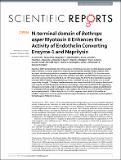Mostrar el registro sencillo del ítem
N-terminal peptide of myotoxin II from Bothrops asper venom enhances the activity of endothelin converting enzyme and neprilysin
| dc.creator | Smith, A. Ian | |
| dc.creator | Rajapakse, Niwanthi W. | |
| dc.creator | Kleifeld, Oded | |
| dc.creator | Lomonte, Bruno | |
| dc.creator | Sikanyika, Nkumbu L. | |
| dc.creator | Spicer, Alexander J. | |
| dc.creator | Hodgson, Wayne C. | |
| dc.creator | Conroy, Paul J. | |
| dc.creator | Small, David H. | |
| dc.creator | Kaye, David M. | |
| dc.creator | Parkington, Helena C. | |
| dc.creator | Whisstock, James C. | |
| dc.creator | Kuruppu, Sanjaya | |
| dc.date.accessioned | 2018-05-03T15:48:54Z | |
| dc.date.available | 2018-05-03T15:48:54Z | |
| dc.date.issued | 2016 | |
| dc.identifier.citation | https://www.nature.com/articles/srep22413 | |
| dc.identifier.issn | 2045-2322 | |
| dc.identifier.uri | https://hdl.handle.net/10669/74605 | |
| dc.description.abstract | Neprilysin (NEP) and endothelin converting enzyme-1 (ECE-1) are two enzymes that degrade amyloid beta in the brain. Currently there are no molecules to stimulate the activity of these enzymes. Here we report, the discovery and characterisation of a peptide referred to as K49-P1-20, from the venom of Bothrops asper which directly enhances the activity of both ECE-1 and NEP. This is evidenced by a 2- and 5-fold increase in the Vmax of ECE-1 and NEP respectively. The K49-P1-20 concentration required to achieve 50% of maximal stimulation (AC50) of ECE-1 and NEP was 1.92 ± 0.07 and 1.33 ± 0.12 μM respectively. Using BLITZ biolayer interferometry we have shown that K49-P1-20 interacts directly with each enzyme. Intrinsic fluorescence of the enzymes change in the presence of K49-P1-20 suggesting a change in conformation. ECE-1 mediated reduction in the level of endogenous soluble amyloid beta 42 in cerebrospinal fluid is significantly higher in the presence of K49-P1-20 (31 ± 4% of initial) compared with enzyme alone (11 ± 5% of initial; N = 8, P = 0.005, unpaired t-test). K49-P1-20 could be an excellent research tool to study mechanism(s) of enzyme stimulation, and a potential novel drug lead in the fight against Alzheimer’s disease. | es_ES |
| dc.language.iso | en_US | es_ES |
| dc.rights | CC0 1.0 Universal | * |
| dc.rights.uri | http://creativecommons.org/publicdomain/zero/1.0/ | * |
| dc.source | Scientific Reports, vol. 6, Article number 22413 | es_ES |
| dc.subject | Myotoxin | es_ES |
| dc.subject | Synthetic peptide | es_ES |
| dc.subject | Beta-amyloid | es_ES |
| dc.subject | Alzheimer | es_ES |
| dc.subject | Snake venom | es_ES |
| dc.title | N-terminal peptide of myotoxin II from Bothrops asper venom enhances the activity of endothelin converting enzyme and neprilysin | es_ES |
| dc.type | artículo original | |
| dc.identifier.doi | 10.1038/srep22413 | |
| dc.description.procedence | UCR::Vicerrectoría de Investigación::Unidades de Investigación::Ciencias de la Salud::Instituto Clodomiro Picado (ICP) | es_ES |
Ficheros en el ítem
Este ítem aparece en la(s) siguiente(s) colección(ones)
-
Microbiología [1171]



